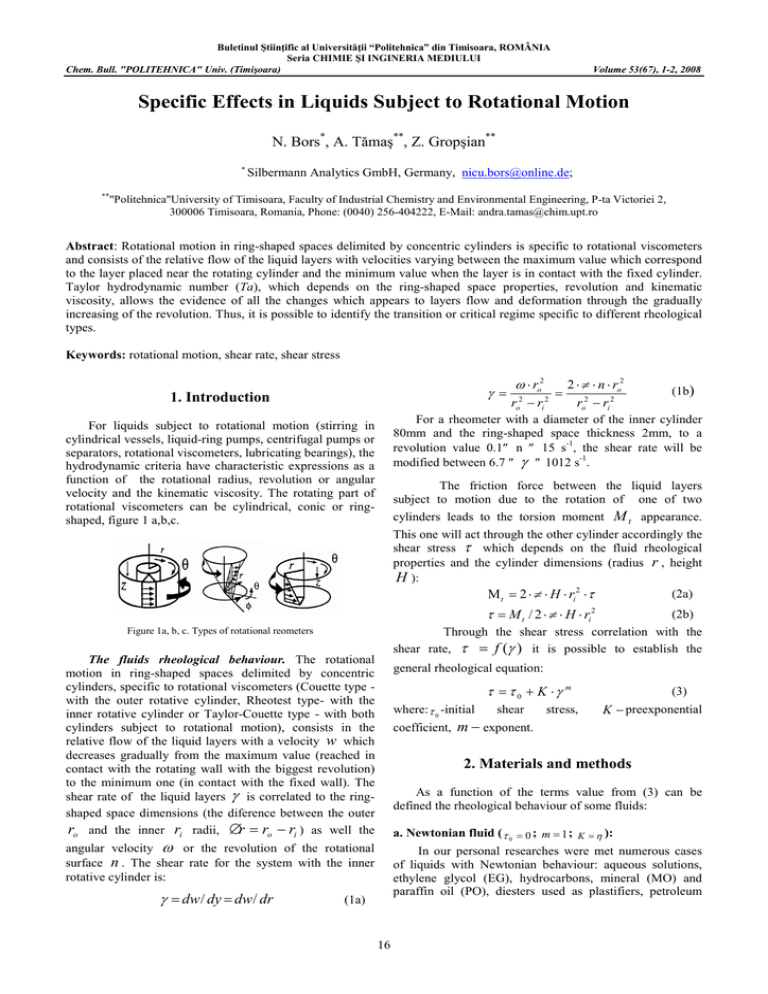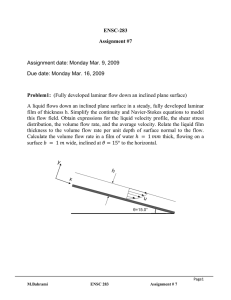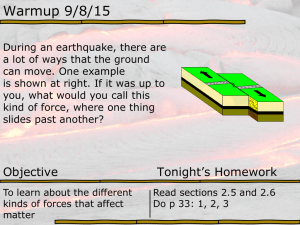Document 13359612
advertisement

Buletinul Ştiinţific al Universităţii “Politehnica” din Timisoara, ROMÂNIA Seria CHIMIE ŞI INGINERIA MEDIULUI Chem. Bull. "POLITEHNICA" Univ. (Timişoara) Volume 53(67), 1-2, 2008 Specific Effects in Liquids Subject to Rotational Motion N. Bors*, A. Tămaş**, Z. Gropşian** * ** Silbermann Analytics GmbH, Germany, nicu.bors@online.de; "Politehnica"University of Timisoara, Faculty of Industrial Chemistry and Environmental Engineering, P-ta Victoriei 2, 300006 Timisoara, Romania, Phone: (0040) 256-404222, E-Mail: andra.tamas@chim.upt.ro Abstract: Rotational motion in ring-shaped spaces delimited by concentric cylinders is specific to rotational viscometers and consists of the relative flow of the liquid layers with velocities varying between the maximum value which correspond to the layer placed near the rotating cylinder and the minimum value when the layer is in contact with the fixed cylinder. Taylor hydrodynamic number (Ta), which depends on the ring-shaped space properties, revolution and kinematic viscosity, allows the evidence of all the changes which appears to layers flow and deformation through the gradually increasing of the revolution. Thus, it is possible to identify the transition or critical regime specific to different rheological types. Keywords: rotational motion, shear rate, shear stress γ = 1. Introduction ω ⋅ ro2 ro2 − ri 2 = 2 ⋅ π ⋅ n ⋅ ro2 ro2 − ri 2 (1b) For a rheometer with a diameter of the inner cylinder 80mm and the ring-shaped space thickness 2mm, to a revolution value 0.1≤ n ≤ 15 s-1, the shear rate will be modified between 6.7 ≤ γ ≤ 1012 s-1. For liquids subject to rotational motion (stirring in cylindrical vessels, liquid-ring pumps, centrifugal pumps or separators, rotational viscometers, lubricating bearings), the hydrodynamic criteria have characteristic expressions as a function of the rotational radius, revolution or angular velocity and the kinematic viscosity. The rotating part of rotational viscometers can be cylindrical, conic or ringshaped, figure 1 a,b,c. The friction force between the liquid layers subject to motion due to the rotation of one of two cylinders leads to the torsion moment M t appearance. This one will act through the other cylinder accordingly the shear stress τ which depends on the fluid rheological properties and the cylinder dimensions (radius r , height H ): (2a) Μ t = 2 ⋅ π ⋅ H ⋅ ri2 ⋅ τ τ = M t / 2 ⋅ π ⋅ H ⋅ ri2 Figure 1a, b, c. Types of rotational reometers Through the shear stress correlation with the shear rate, τ = f (γ ) it is possible to establish the The fluids rheological behaviour. The rotational motion in ring-shaped spaces delimited by concentric cylinders, specific to rotational viscometers (Couette type with the outer rotative cylinder, Rheotest type- with the inner rotative cylinder or Taylor-Couette type - with both cylinders subject to rotational motion), consists in the relative flow of the liquid layers with a velocity w which decreases gradually from the maximum value (reached in contact with the rotating wall with the biggest revolution) to the minimum one (in contact with the fixed wall). The shear rate of the liquid layers γ is correlated to the ringshaped space dimensions (the diference between the outer ro and the inner ri radii, ∆r = ro − ri ) as well the general rheological equation: τ = τ0 + K ⋅γ m where: τ 0 -initial coefficient, shear m − exponent. stress, (3) K − preexponential 2. Materials and methods As a function of the terms value from (3) can be defined the rheological behaviour of some fluids: a. Newtonian fluid ( τ 0 = 0 ; m = 1 ; K = η ): In our personal researches were met numerous cases of liquids with Newtonian behaviour: aqueous solutions, ethylene glycol (EG), hydrocarbons, mineral (MO) and paraffin oil (PO), diesters used as plastifiers, petroleum angular velocity ω or the revolution of the rotational surface n . The shear rate for the system with the inner rotative cylinder is: γ = dw / dy = dw / dr (2b) (1a) 16 Chem. Bull. "POLITEHNICA" Univ. (Timişoara) Volume 53(67), 1-2, 2008 (MF-P, with saturation magnetization 900Gs) or paraffin oil (MF-PO) based magnetic fluids [1,2]. The dependence τ = f (γ ) is presented in figure 2a and the rheological 60 50 Shear stress, Pa equations in Table 1. b. Viscoplastic fluid ( τ 0 ≠ 0 ; m = 1 ): The behaviour of this rheological type can be described using Bingham law (4a) or Newton law (4b): (4a) η = η0 + τ 0 δ τ = τ 0 + η0 ⋅ γ 40 4% Span 60 30 4% Span 80 20 10 0 0 (4b) 200 400 600 800 1000 1200 1400 Shear rate, s-1 τ 0 and η 0 depends on the thermodynamic state. For τ < τ 0 , the fluid presents a very rigid molecular structure 2b 60 and behaves as a solid body. If τ > τ 0 the molecular structure is destroying and behaves as a liquid. Characteristic types of viscoplastic fluids are: drilling mud, fresh cement, dyes. In our experiments, W/O/W multiple emulsions based on water and paraffin oil (20% paraffin oil, 1% hydrophilic emulsifier Brij 35, 4% lipophilic emulsifier Span 60) present this type of behaviour, figure 2b[3]. Shear stress, Pa 50 40 t1=30C 30 t2=60C 20 10 0 0 c. Pseudoplastic fluid ( τ 0 ≠ 0 ; m < 1 ) Dynamic viscosity of this fluids type decreases through the shear rate increasing. The phenomenon is specific for different solutions of organic materials. The explanation of viscosity decreasing consists in the orientation of asymmetric molecules for the substance in solution, on the flow direction (position with minimum friction). As examples can be mentioned: fats, solutions of cellulose derivates, inks, oil products, blood plasma, latex rubber, polymeric solutions. In our experimental studies we met this type of rheological behaviour to multiple emulsions with magnetic fluid content (25% oil based magnetic fluid, 4% lipophilic emulsifier Span 85, 1% hydrophilic emulsifier Tween 65)[4] and to pastes used to cotton textures covering (47.7% water, 50% covering material, 1.5% agglutinant, 0.8% emulsifier and antifoam), figure 2c [5,6]. 20 40 60 80 100 120 140 160 Shear rate, s-1 2c Figures 2a,b,c. The shear stress τ vs the shear rate γ d. Dilatant fluid ( τ 0 = 0 ; m < 1 ). This behaviour is characteristic to high concentrated suspensions where the liquid phase is placed only between solid particles. Also, when the shear rate increases, the solid particles tend to brake the layers relative flow. e. Thixotropic fluids have a resistance to deformation that depends upon deformation rate and time. The previous classification is schematic. There are complex fluids with simultaneous pseudoplastic, viscoplastic and thixotropic behaviour. 3. Results and discussion 30 The temperature influence. Temperature increasing leads to an accentuated viscosity decreasing; this phenomenon is described by an exponential equation (Arrhenius type), whose the main characteristic is the activation energy of viscous flow E a : Shear stress, Pa 25 20 MF-P 900Gs, t1=20C PO, t=40C 15 MF-P 900Gs, t2=40C EG, t=40C 10 5 E a = A ⋅ e Ea 0 0 200 400 600 800 1000 1200 1400 -1 Shear rate, s 2a 17 R ⋅T (5) Chem. Bull. "POLITEHNICA" Univ. (Timişoara) Volume 53(67), 1-2, 2008 Making measurements at different temperatures and using the graphical representation ln τ = f (1 T ) was possible to calculate the activation energy of viscous flow E a and the pre-exponential factor A, Table 2. external energy is accumulated as elastic deformation energy; the behaviour of these fluids at high shear rate values is similar to elastic fluids, figure 3. Elastic components from viscoelastic fluids can not be eliminated. From this reason it is necessary a preliminary measurement to determine the shear rate and time influence about the sample viscosity and elasticity before to establish the rheometer type used for rheological research of an unknown substance. For Non-newtonian fluids is more accurate to present, as Arrhenius type equation, the shear stress dependence as a function of temperature at certain shear rate value. For Newtonian fluids, through the shear rate increasing, the stationary state is reached almost momentary and the friction energy taken over the rotative cylinder is integrally transformed into heat. The stationary state of viscoplastic fluids is reached after a transition time when a a part of the The rheological categories present different manifestation when are subjected to rotational motion due to the centrifugal, gravitational and viscous forces. TABLE 1. Rheological equations Rheological equation A2 τ = τ 0 + K ⋅γ m τ = 0.017 ⋅ γ τ = 0.028 ⋅ γ Paraffin oil, t=25°C Newtonian A3a τ = 0.0192 ⋅ γ Oil based magnetic fluid (magnetization 900 Gs), t=20°C Newtonian A3b τ = 0.0124 ⋅ γ Oil based magnetic fluid (magnetization 900 Gs), t=40°C Newtonian B1a τ = 2 .04 + 0.015 ⋅ γ Multiple emulsion based on water and paraffin oil (4% Span 60) Viscoplastic B1b τ = 5.46 + 0.035 ⋅ γ Multiple emulsion based on water and paraffin oil (4% Span 80) Viscoplastic Pastes for cotton textures covering Pseudoplastic Multiple emulsion based on magnetic fluid Pseudoplastic Position A1 C1 τ = 46.8 + 16. 9 ⋅ γ C2 τ = 4 .58 + 2.14 ⋅ γ 0 . 48 0 . 62 The fluid nature and the main characteristics The fluid rheological type Ethylene glycol, t=25°C Newtonian TABLE 2. Values of activation energy and pre-exponential factor [1,2,4] Liquid Ethylene glycol Paraffin oil MF-P-900 MF-PO-400 η = A ⋅ eE a / R ⋅T η = 5.6 ⋅ 10 −6 ⋅ e 3080 / T η = 5. 2 ⋅ 10 − 7 ⋅ e 3240 / T η = 5. 6 ⋅ 10 − 6 ⋅ e 2110 / T η = 2 .3 ⋅ 10 − 7 ⋅ e 4020 / T Ea , [kJ.mol-1] 25.6 26.9 17.5 33.4 Thus, the viscous liquids with a behaviour close to Newtonian fluids present in rotation a parabolic surface and are raised on the vessel walls. The liquids with elastic behaviour adhere and raise on the mixer rod, figure 4. The systems of viscosity measurement with coaxial cylinders come from the Newtonian model with plane parallel surfaces where the two plates were assimilated to lateral surfaces of the two cylinders. Into the ring-shaped space is introduced the fluid which can be submited to a shearing process, identical with the fluid placed between the plane plates. For an exactly mathematical interpretation some conditions needs to be carried out: laminar flow, stationary state, lower walls adherence, sample’s homogeneity, the absence of chemical and physical transformations during the measurement, the absence of sample’s elasticity. Figure 3. Viscosity and elasticity dependence as a function of shear rate 18 Chem. Bull. "POLITEHNICA" Univ. (Timişoara) Volume 53(67), 1-2, 2008 These criteria allow quantitative estimation of certain modifications which appear in liquids subject to rotational motion in ring-shaped spaces due to layers deformation through gradually revolution increasing. Thus, is possible to identify the transition or critical regime specific to different rheological types. Through the limit exceeding of laminar flow regime the circular current lines are deformed and become corrugated (Taylor-Couette instability). Figure 4. The liquid surface form to a rod rotation ( d = 9.5 mm, n = 10 s −1 ): oil (Newtonian fluid) and polyisobutene (elastic fluid) [7] The first rotational rheometer was conceived and built by Maurice Couette in 1890 [8] and contained an external rotative cylinder V and an inner one s suspended by a torsion wire C'. Into the ring-shaped space between cylinders there is the liquid sample. By rotation of the outer cylinder, the liquid placed in the ring-shaped space is set in turbionar motion which act about the inner cylinder and produced the partial rotation and the wire torsion. The unghiular deflection is measured using the mirror ν' and allows the torsion moment estimation for the inner cylinder. Figure 6. Taylor-Couette instability (to the exceeding of laminar regime) The end effect. To measurement results evaluation, the rotation moment is considered proportionally to viscosity and is calculated as an effect of the friction force from the ring-shaped space. Both rotor end zones induce an additional effect but, through the selection of a suitable geometry for the device with coaxial cylinders, the errors can be minimized [10]. In figure 7 are presented different constructive types of rotative cylinders (sensors) for end effect decreasing: (a) bell-shaped hereupon both lateral faces are active; (b) with engrossed cylinder extremities – the inferior concavity remains filled with air and the friction is negligible due to very low viscosity; (c) with concave ending for the outer cylinder and conical for the rotor; (d) with standardization and correlation of dimensions ratios. Taylor-Couette instability. Hydrodynamic regime Reynolds particularized for the flow in ring-shaped spaces under the rotational motion effect is known as TaylorReynolds criteria Ta Re and depends on the angular velocity, cylinders radii and kinematic viscosity [9]. The transition domain between laminar and turbulent motion is considered 60 ≤ Ta Re ≤ 1712 . Ta Re = ω ⋅ ri ⋅ (ro − ri ) ν (6) Taylor hydrodynamic criteria defined as the ratio between the centrifugal force and the viscous friction one depends on the geometry of the ring-shaped space (radii of the two cylinders), revolution, and liquid properties: Ta = Fcentrif Fviscous = ω2 ⋅ ri ⋅ (re − ri ) ν 2 3 (7) (a) (c) (b) (d) Figure 7. Constructive types of rotative cylinders for the end effect decreasing Figure 5. The original Couette rheometer 19 Chem. Bull. "POLITEHNICA" Univ. (Timişoara) Volume 53(67), 1-2, 2008 Modified Couette rheometer. For the study of certain effects which appear to liquids rotational motion in ringshaped spaces in transition regime, was conceived and achieved a modified Couette rheometer, figure 8. A, B - coaxial glass cylinders; C- elastic coupling; D- the adjustment of elastic tube high; E- attachement ring; Fcoupling bars; G- disk for the torsion measurement; Hstretching thread with regulating loop; 1a,1b- the revolution inductive detector; 2a, 2b- magnetic system for the torsion measurement; 3- force detector; 4- raising system actuated by a step by step engine; - Slide sealing with circular plane surfaces; - Revolution adjustment through frequency modulation; - The cylinder torsion angle is noted and changed in unified electric signal which can be amplified and modulated (analized by an osciloscope or graphic recorded); - For significant sizes there are interfaces for data acquisition; - The entire cylinders ensemble is under thermostatic control. The cylinders were glass made; the inner is subject to a controled and adjustable rotational motion and the outer is setting into an elastic joint. Its oscillations (the torsion angle) are correlated to the resisting moment which appears due to the friction transmitted through the liquid placed between the two cylinders. Based on these calculations it were considered as optimal the next values: inner radius 40mm, the ring-shaped space thickness 2mm, height 290mm; revolution domain for water 0.02÷6s-1. placed on the rheometer body (2a,b) thus to appear an 0.1÷2mm interstice. Through the magnetic belt removal, impulses are registrated by the sensor and is possible to measure the circular curve which the disk is rotate. Standardization indicated that to one rotation are recorded 224.4 impulses, which corresponds to an 1.6 degree/impulse angle (28x10-3 rad/impulse). The outer cylinder suspended on its top using a thin, resistant and non-extensible thread, lightly torsionable (H) is stretched by a stepper motor. Thus, it is produced a determined straining of the fastening elastic system (C). As a function of the certain thread strainings, through standardization using a torsion balance, the dependence between the rotation angle and the torsion moment was established, figure 9. Torsion moment x103, N.m 150 120 F2=1.5F1 90 F1 Linear (F2=1.5F1) 60 Linear (F1) 30 0 0 5 10 15 20 25 30 Central angle x103, rad Figure 9. The torsion moment vs. central angle The dependence between the torsion moment M t and the central angle ∆θ is reperesented through the followed equations (8a for F1 and 8b for F2=1.5F1): (8a) M t = 5 ⋅ ∆θ + 10.6 ⋅ 10 −3 M t = 7 ⋅ ∆θ + 24.2 ⋅ 10 −3 (8b) 4. Conclusions - The rotational motion of liquids in ring-shaped spaces presents characteristics determined by the shear rate of parallel layers and the shear stress is influenced by the liquid nature and the deformation strenght; - The effects which appear can be characterized using specific rheological equations; the geometry of ring-shaped spaces and the liquid properties influence the flow hydrodynamic regime and the surface form; - The achievement and standardization of a rotative rheometer allow a complex study of the liquids rheological behaviour, into a large flow domain. REFERENCES Figure 8. Modified Couette rheometer (automating variant) 1. Tămaş, A., Borş, N., Minea R., Bul.Univ.Petrol-Gaze din Ploieşti, Seria Tehnică, 2008, in press. 2. Minea, R., Teză de doctorat, Univ. Politehnica din Timişoara, 1999. 3. Tămaş, A., Urşica, L., Minea, R., Ovidius University Annals of Chemistry, 2002, 13(1), pp.72-74. The measurement of the outer cylinder torsion is realized using a magnetic measure sytem without contact. It consists of a magnetic belt fixed on a disk surface solidary mounted with cylinder and a magnetic sensor 20 Chem. Bull. "POLITEHNICA" Univ. (Timişoara) Volume 53(67), 1-2, 2008 4. Tămaş, A., Teză de doctorat, Univ. Politehnica din Timişoara, 2004 5. Minea, R., Mihuţa, S., Tămaş, A., Analele Univ. "A.Vlaicu" din Arad, Seria Textile, 2002, pp.101-104. 6. Tămaş, A., Minea, R., Mihuţa, S., 4th International Conference of PhD Students, Miskolc, 2003, vol. Eng. Sciences II, pp. 405-410. 7. Beavers, G.S., Joseph, D.D., J.Fluid Mech., 1975, 69, pp. 475. 8. Couette, M.A., Annales de Chimie et de Physique, 1890, 21, pp. 433510 9. Lewis, G.S., Swinney, H.L., Physical Review E, 1999, 59(5), pp. 54575467 10. Kobayashi, H., Nashima, T., Okamoto, Y., Kaminaga, F., Rev. Sci. Instrum., 1991, 62(11), pp. 2748-2750. 21




